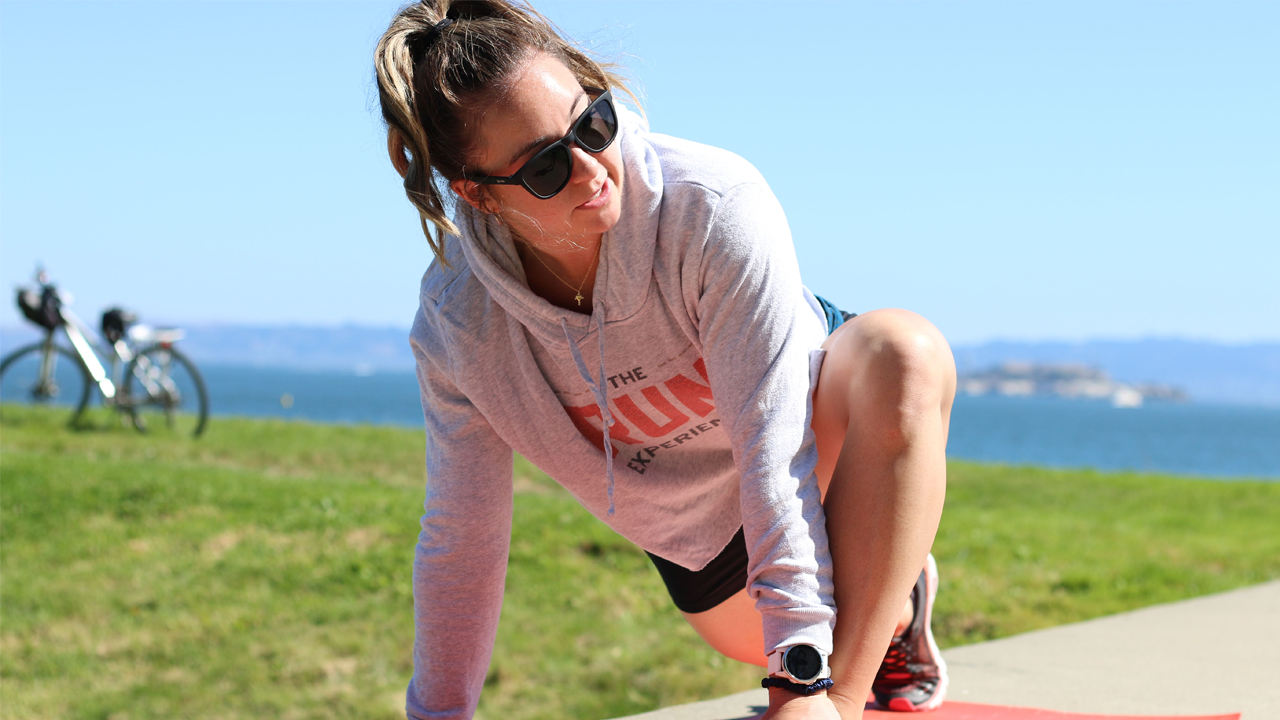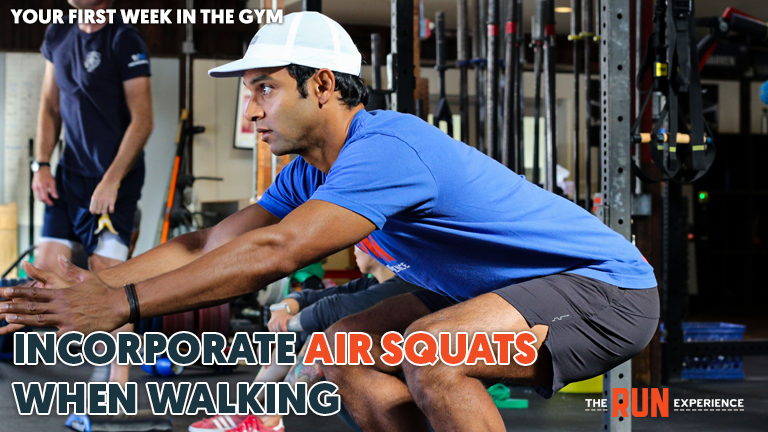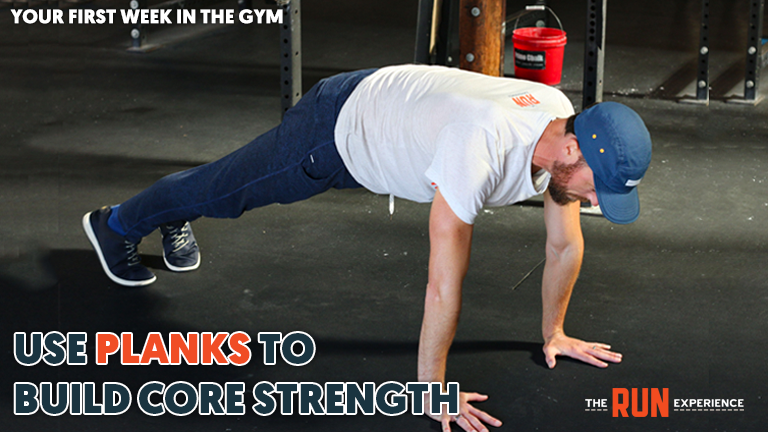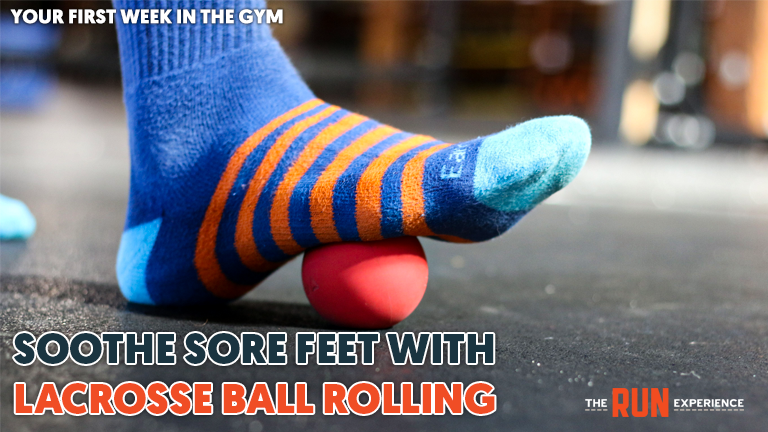Gym Workout Plan for Beginners: Your First Week in the Gym
We designed this gym workout plan for beginners to help you with your first week in the gym—and beyond. Give it a read to get a good foundation.

Once you’ve decided to become a runner, it’s a great idea to start a beginner’s workout plan to get you started and help you reach your goals, whether it be running your first 5k or weight loss. This beginner workout plan will incorporate running with strength work–and full-body strength is key to becoming a good runner, prevent injuries, build muscle, encourage fat loss, and enjoy running!
Let’s start out with three workouts of what your first week will look like. You can make them gym workouts, do them outside, or even do some of them at home!
Gym Workout Plan for Beginners: What to Know
Stepping into the gym for the first time is not just a physical commitment but a holistic one. Get all the nitty-gritty details right, and you'll protect your longevity and reap all the long-term running benefits.
This guide is crafted to navigate you through your initial week in the gym while also equipping you with foundational knowledge to sustain and enjoy your fitness journey.
Nourishing Your Body
Your body is your vehicle through this journey, and fueling it correctly is paramount. Adopt a balanced diet that encompasses carbohydrates, proteins, fats, vitamins, and minerals to support your workout and recovery. Consider consulting a nutritionist to curate a meal plan that aligns with your fitness goals and dietary preferences. Remember, your nutrition is not just about aiding your workouts but also about fostering overall well-being.
The Pillar of Sleep
Never underestimate the power of a good night’s sleep, especially when you’re pushing your body in the gym. Sleep is when your body undergoes repair and recovery, crucial for muscle development and avoiding fatigue. Aim for 7-9 hours of sleep nightly to ensure you’re recharged and ready to tackle your next workout with vigor.
Recovery: A Silent Warrior
While the adrenaline of lifting weights or sprinting on the treadmill might be enticing, respecting your body’s need for recovery is crucial. Integrating rest days, indulging in light activities, and perhaps adopting practices like yoga or meditation can enhance recovery and shield you from burnout and injuries.
Preventing Injuries
As a beginner, the eagerness to witness results might tempt you to push beyond your limits. However, understanding and respecting your body’s boundaries is vital to prevent injuries. Ensure you’re adopting the correct form, utilizing appropriate weights, and gradually escalating your workout intensity. Don’t shy away from seeking guidance from trainers to ensure your techniques are safe and effective.
Mental and Emotional Well-being
Your mental fortitude will be your unwavering ally on this journey. Celebrate every milestone, be patient with your progress, and embrace the learning curve. Fitness is not just a physical transformation but a mental and emotional one too. Engage in practices that nourish your mind and soul, ensuring that your fitness journey is sustainable and enjoyable.
Your First Week in the Gym
Let’s start out with a sample week-long workout program for starting running if you’re overweight. Even if you’re not overweight, this workout routine is great if you’re brand new to running!
Monday–30-Minute Walk
We’ll start out with a simple 30-minute walk. However, pick up the pace from more than a leisurely walk. Think of more as a cardio power walk and aim to get your heart up a little bit.

- During the walk, stop every 10 minutes for air squats.
- Start by standing tall with your feet hips-width distance apart and toes pointed straight ahead.
- Bring your belly button into your spine a bit to engage your core.
- Reach your hips back as if you’re sitting in a chair and press your knees out wide, then push up the same way you went down.
- Make sure you keep your chest tall so you’re not falling over when you go down. This helps make sure your knee stays right over your ankle and you’re not pushing it past over your toes so you don’t overload the joints.
- Make sure to push back up through your heels to engage the glutes.
- If you’re new to squats, start with 10 and don’t try to go too low at first, but get a little lower each squat. If you’re more experienced with them, challenge yourself to do 20, try going as low as you can.
Training tip: As you get more experienced, consider holding a dumbbell as you do the squats.
We will end with a five-minute stretch routine after your walk to make sure you’re taking care of those muscles.

- Find a bench and put your arms on the top of it. Walk your feet back until you’re in an elevated plank position.
- With your body straight, focus on dropping your heels as low as you can into the ground–you should be feeling a good stretch in your calves.
- Reach your chest up and reach your hips back while keeping your legs as straight as possible. If you don’t have much hamstring flexibility yet, feel free to bend your knees in a little bit.
- With your arms out, reach your head down and find a stretch that engages the backs of your legs and opens up your hamstrings while relaxing your heels into the ground.
- Go back to your starting position
Spend five minutes taking care of yourself by spending about three minutes doing this exercise with a few breaks built in. We want to make a habit of stretching and self-care at the end of every workout.
Tuesday–Strength Day
It’s time to get into our first strength workout! Plus, it only takes about 15 minutes, with four total movements that engage different muscle groups using your own bodyweight.
1. Shoulder Taps
- Find a bench or elevated surface a few feet off the ground.
- Place your hands right under your shoulders and walk your feet back. You can start with your feet hip-width apart, or bring them in closer together for a challenge.
- Once you’re in this position, tap one hand to the opposite shoulder and alternate the shoulder reps for 20 total reps.
- The key to this movement is not letting your hips swing, so stay focused on keeping them in place by keeping your core nice and stable.
2. Box Squats
- Just like with the air squats yesterday, find your tall stance, bring the belly button into the spine, and engage your glutes.
- Today we will use that bench or elevated surface as a target to have something to land on, improving your position and teaching you to get a little lower in the squat.
- Keeping the chest up, reach your hips back and sit down on the bench. If you need a little momentum, you can rock back an inch or two and roll yourself back up to standing. If you want more of a challenge, stay stable on the bench and use the weight into your heels to stand back up, for a total of 10 box squats.
3. Alternating Step-Ups
- Start by standing in front of your elevated surface or bench.
- Reach the hips back, and step one leg up onto the bench, loading the back of the legs and making sure the knees are completely vertical over the lower leg.
- Keeping your chest up, bring your other leg up to the bench, then step down with that same leg.
- Do the same thing but start with the alternate leg. Reach those hips back, push the hips at the top, for a total of 10 alternating step-ups.
- The hip extension and finding the full push forward at the top is going to teach you to do that while you run and help prevent injuries.
4. Crab Walk Alternating Touch
- This alternating touch exercise will work the triceps and improve hip stability.
- Stand facing away from your bench or elevated surface and sink down, placing your hands on the bench with your feet and legs in front of you.
- With as little movement as possible in your lower body, stabilize your core and find full extension through the arm that is supporting you, while tapping your other hand to the same shoulder for a total of 20 reps.
- For a little more challenging version, take it down to the ground, pushing yourself up into a bridge position, then alternate tapping your shoulders.
Complete four rounds of these exercises with three minutes of rest in between. Go at a nice easy pace where you’re working correctly rather than rushing through.
After your strength workout, go for a short walk while doing some dynamic stretching. Incorporate arm circles to help open up your chest. You can also do a few knee hugs to loosen up your leg muscles.
Wednesday–Rest Day
This is your first rest day. It’s a chance for your body to recover and let those muscles you’ve been working the last two days have a chance to repair. However, a rest day doesn’t mean you lose your focus on training for a day, there are still two things you can work on.
Firstly, focus on hydration and making sure you get enough water intake. It will set you up for success for the rest of the week and help replenish your body. An easy rule of thumb is that if your urine is clear, you’re good and hydrated.
Secondly, work in 10 quick minutes of mobility work. Here’s a great video from Coach Holly that guides you through mobility work for beginners:
Training Tip: You can use a lacrosse ball for lots of mobility work, including soothing sore feet!

Thursday–Hill Repeats
Time to get moving with some hill repeats! We will stick to walking, but we’ll be adding some incline today to help get the heart rate up. We’ll have recoveries in between so you always have a chance to catch your breath. The main focus here is to start getting you comfortable feeling a little uncomfortable.
- Find a hill with about a five to eight percent incline. You can also do this on a treadmill and just set the incline.
- Power hike up the hill for one minute. You’ll want to go a little faster than you would on flat ground, and keep your hips forward while engaging your glutes and keeping your hamstrings firing the entire time you’re moving up the hill. Don’t forget to use your arms to help propel you as you hike up the hill and focus on big inhales through the nose, and exhaling fully.
- Take about two minutes of recovery time to walk back down and catch your breath. If you’re on the treadmill, simply lower the incline to zero.
- Do 10 hill repeats, but feel free to adjust if it feels like too much. You can always work your way up, especially if you’re just starting out.
We will wrap up with a brief stretching routine:
- Stand and pound out your quads with your fists. Start with your left leg and pound out those the front of your quad muscle similar to like you’re tenderizing a piece of meat!
- Work your way out to each side, and repeat on the other leg, helping to work out some of that lactic acid your body is building up.
Friday–Circuit Workout
Day five of the week brings us to a circuit workout, similar to the strength training we did on day two. However, it’s done in a little more cardio style format, so expect to get your heart rate up a bit more. You’ll learn how to pace yourself through a variety of workouts, including a little jogging. You’ll complete four rounds of this circuit.
- Start with a 30-second jog followed by a 30-second walk. If that feels too easy, you can jog the whole minute.
- Next, you’ll go into a 30-second plank. You can use a bench or elevated surface to make it easier or do it on the ground for more of a challenge. Place your hands right under your shoulders and walk your feet back until your body is straight.
- You should have your legs all the way together, squeeze your butt, and engage your core. This will work your upper body and core at the same time.
- Focus on deep slow breathing for 30 seconds.
- Next, we have 20 oblique twists. Stand tall and raise your arms with your fingers behind your ears. Then you’ll tuck one knee into your body, then the other, finding a little march that engages your obliques, keeping the elbows wide above your head.
- Finally, add 10 jumping jacks. Make sure your heels touch the ground every time you land rather than landing on your toes, which will aggravate your calves. Be sure to stand tall and avoid arching your back.
Complete four rounds of this workout, resting between one and three minutes in between each round. Time each round to see if you’re holding a consistent pace. If you find you’re slowing down each round, you may be starting out too fast. If you’re getting faster every time, you may want to start out working a little harder.
We’ll end by doing some core stretches:
- Find an elevated surface and put one foot up on it. Walk the other foot back so you’re in a lengthened standing lunge position.
- Push your hips forward and try to find a stretch all the way through the front of the hip and then deeper into the core. You’ll start to feel your ab muscles stretching.
- To get an extra stretch, raise the arm up on the same side as the rear leg. Reach your arm back a bit to get a diagonal stretch.
- Take ten deep breaths on each side.
Saturday–Fun Active Recovery Day
Rest days don’t all have to be the same. Today, you’ll simply pick an activity of your choice that you enjoy which gets you moving a bit without being intense. Here are a few examples:
- An easy bike ride with a friend
- A leisurely walk
- Play frisbee
- Go swimming
- Play with your kids at the park
- Do some light free weights at home
The bottom line, have fun being a little active!
Sunday–Let’s Run!
You’ve made it through a lot this week, especially if you’ve been sedentary for awhile–great work! This last day is the pinnacle of the week where you get to explore jogging with an easy way to get started that won’t feel overwhelming. Here’s the workout:
- We will run for 20 minutes, but broken down into a run/walk method.
- Start with 30 seconds of jogging, then one minute of walking.
- As you get more comfortable with this and your fitness level improves, you can increase your jog time and play with decreasing your walk time. Listen to your body!
Don’t forget to start every run with a good, dynamic warm up. Follow along with Coach Holly for a seven-minute running warm up you can use before every run:
Start Your Gym Training
Follow this gym workout plan for beginners to get on your way towards fulfilling your potential as a strong runner and reach your fitness goals. Finally, don’t forget to download our new mobile app for access to coaching advice, daily video workouts, injury prevention tips, and complete training programs that will help motivate and inspire your training program!
